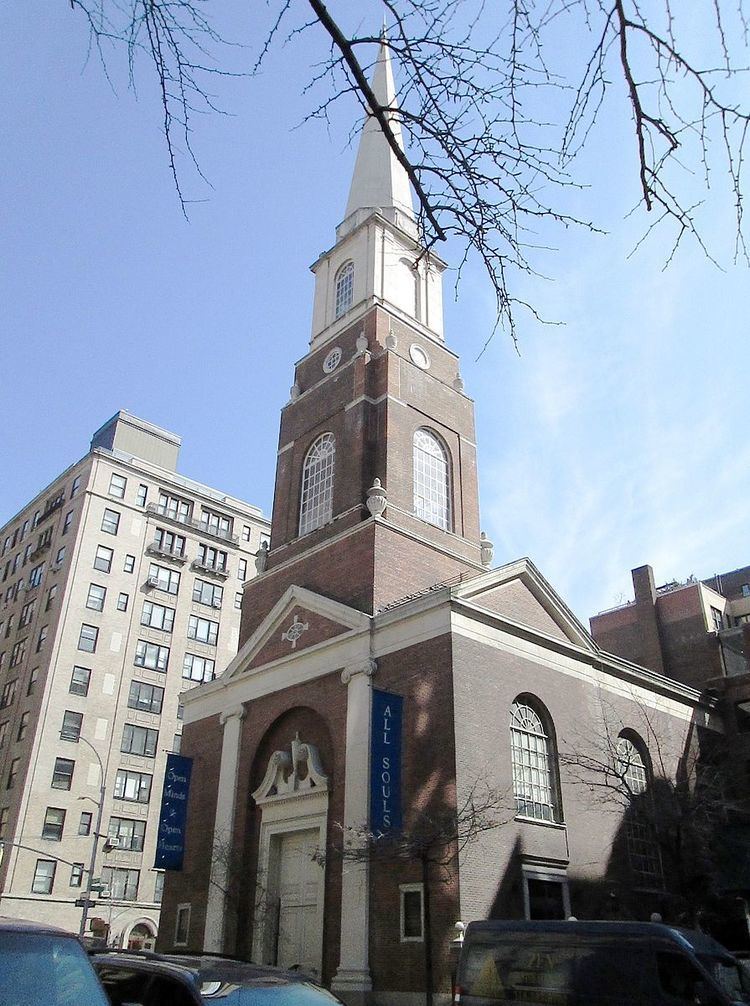Direction of façade west Phone +1 212-535-5530 | Materials Brick, wood, stone Year consecrated 1819 | |
 | ||
Address 1157 Lexington Ave, New York, NY 10075, USA Similar All Souls Church - Unitarian, First Unitarian Congreg, All Souls Unitarian Church, Holy Trinity Episcopal Church, Church of the Epiphany Profiles | ||
Ralph nader at unitarian church of all souls in nyc 3 12 2010
The Unitarian Church of All Souls at 1157 Lexington Avenue at East 80th Street in the Upper East Side of Manhattan, New York City was built in 1932 and was designed by Herbert Upjohn – Richard Upjohn's grandson – in the Neo-colonial style with a Regency-influenced brick base. It is the congregation's fourth sanctuary. It was the first Unitarian Universalist congregation in the city. It has provided a pulpit for some of the movement's leading theologians and has also recorded many eminent persons in its membership.
Contents
History
All Souls was the first Unitarian congregation to be organized in New York and originated in 1819 when Lucy Channing Russell invited forty friends and neighbors into her Lower Manhattan home, to listen to an address by her brother, William Ellery Channing, the minister of the Federal Street Church in Boston. Channing was making a stop in New York while traveling to Baltimore to preach the famous sermon in which he would articulate the distinctive tenets of Unitarian Christianity, the most salient of which were the rejection of the Trinity in favor of absolute Monotheism, and the imperative to interpret the Bible through reason. In New York, the enthusiasm aroused by Channing culminated in the formation of the First Congregational Church (Unitarian), which proceeded to erect its first building in 1820-21, on Chambers Street between Broadway and Church Street, before it had even found a minister. The task of recruitment was difficult since few ministers could be persuaded to venture away from the stability of the Unitarian heartland in New England and risk their careers in new congregations beyond. Finally, on December 18, 1821, William Ware was installed as the first minister.
In 1845, the congregation moved to a new building at 548 Broadway and renamed itself the Church of the Divine Unity the following year. In 1855, the present name, All Souls, was taken by an American church for the first time when the congregation dedicated its third building at 249 Fourth Avenue (now Park Avenue South) at 20th Street. The new church was designed by Jacob Wrey Mould and featured bands of red and white bricks and Caen stone, which led to the colluquial names of "The Holy Zebra" and "The Beefsteak Church."
In partnership with minister Henry Whitney Bellows, who served for over four decades from 1839 to 1882, All Souls grew to include some of the leading social reformers and cultural figures of the city, such as Peter Cooper, Herman Melville, and others. One noted member was the novelist Catharine Sedgwick, who remarked upon the diverse backgrounds of the people who were attracted to the freedom of ethical inquiry which All Souls offered: "strangers from inland and outland, English radicals and daughters of Erin, Germans and Hollanders, philosophic gentiles and unbelieving Jews . . . In this, our ass'n, there is at least one of every sort." In evolving from its roots in Unitarian Christianity, All Souls has embraced an enlarging religious pluralism that continues to this day.
All Souls relocated to its current building on the Upper East Side at 1157 Lexington Avenue at 80th Street in 1932, designed by Richard Upjohn's grandson, Herbert Upjohn in the Colonial Revival style with a Regency-influenced base. Forrest Church, the prolific author and theologian, the served as Senior Minister for almost thirty years until the beginning of 2007, when, due to terminal cancer, he was succeeded by Galen Guengerich and assumed the less strenuous duties of Minister of Public Theology. Church's charismatic style has been credited with the revitalization of the congregation.
